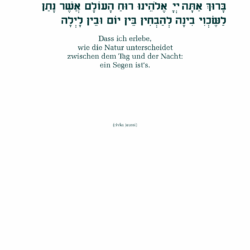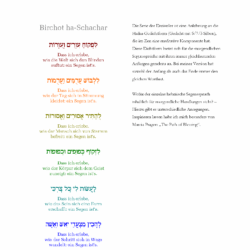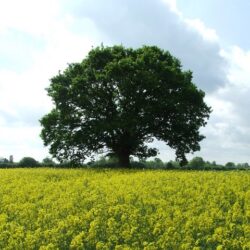| Source (Hebrew) | Adaptation (German) | Translation of Adaptation (English) |
|---|---|---|
|
בָּרוּךְ אַתָּה יְיָ אֱלֹהֵינוּ מֶלֶךְ הָעוֹלָם אֲשֶׁר נָתַן לַשֶּׂכְוִי בִינָה לְהַבְחִין בֵּין־יוֹם וּבֵין לָיְלָה׃ |
Dass ich erlebe,
wie die Natur unterscheidet zwischen dem Tag und der Nacht: ein Segen ist‘s. |
That I experience
how nature distinguishes between day and night: it is a blessing. |
|
בָּרוּךְ אַתָּה יְיָ אֱלֹהֵינוּ מֶלֶךְ הָעוֹלָם פּוֹקֵחַ עִוְרִים׃ |
Dass ich erlebe,
wie die Welt sich den Blinden auftut: ein Segen ist‘s. |
That I experience
how the world opens up to the blind: it is a blessing. |
|
בָּרוּךְ אַתָּה יְיָ אֱלֹהֵינוּ מֶלֶךְ הָעוֹלָם מַלְבִּישׁ עֲרֻמִּים׃ |
Dass ich erlebe,
wie der Tag sich in Stimmung kleidet: ein Segen ist‘s. |
That I experience
how the day dresses itself in atmosphere: it is a blessing. |
|
בָּרוּךְ אַתָּה יְיָ אֱלֹהֵינוּ מֶלֶךְ הָעוֹלָם מַתִּיר אֲסוּרִים׃ |
Dass ich erlebe,
wie der Mensch sich von Starrem befreit: ein Segen ist‘s. |
That I experience
how people free themselves from rigidity: it is a blessing. |
|
בָּרוּךְ אַתָּה יְיָ אֱלֹהֵינוּ מֶלֶךְ הָעוֹלָם זוֹקֵף כְּפוּפִים׃ |
Dass ich erlebe,
wie der Körper sich dem Geist zuneigt: ein Segen ist‘s. |
That I experience
how the body inclines itself toward the spirit: it is a blessing. |
|
בָּרוּךְ אַתָּה יְיָ אֱלֹהֵינוּ מֶלֶךְ הָעוֹלָם שֶׁעָשָׂה לִי כׇּל־צָרְכִּי׃ |
Dass ich erlebe,
wie das Sein sich eine Form erschafft: ein Segen ist‘s. |
That I experience
how being creates a form for itself: it is a blessing. |
|
בָּרוּךְ אַתָּה יְיָ אֱלֹהֵינוּ מֶלֶךְ הָעוֹלָם הַמֵּכִין מִצְעֲדֵי־גָבֶר׃ |
Dass ich erlebe,
wie der Schritt sich in Wege wandelt: ein Segen ist‘s. |
That I experience
how the step transforms into paths: it is a blessing. |
|
בָּרוּךְ אַתָּה יְיָ אֱלֹהֵינוּ מֶלֶךְ הָעוֹלָם אוֹזֵר יִשְׂרָאֵל בִּגְבוּרָה׃ |
Dass ich erlebe,
wie der Anfang sich ins Jetzt einwebt: ein Segen ist‘s. |
That I experience
how the beginning weaves itself into the present: it is a blessing. |
This abridged adaptation of the birkhot hashaḥr combines two separate works of Rivka Jaussi. The first: a translation of the blessing for distinguishing between day and night. The second: a series of haikus in German for seven out of the dozen or so “berakhot shenitani” (“you [Hashem] gave me”). Introducing the haiku adaptations, Rivka writes:
Source (German) Translation (English)
For a melody, Rivka Jaussi suggests: „Ha-noten la-Sechwi“ (Anshe Emet Synagogue).
Source(s)



